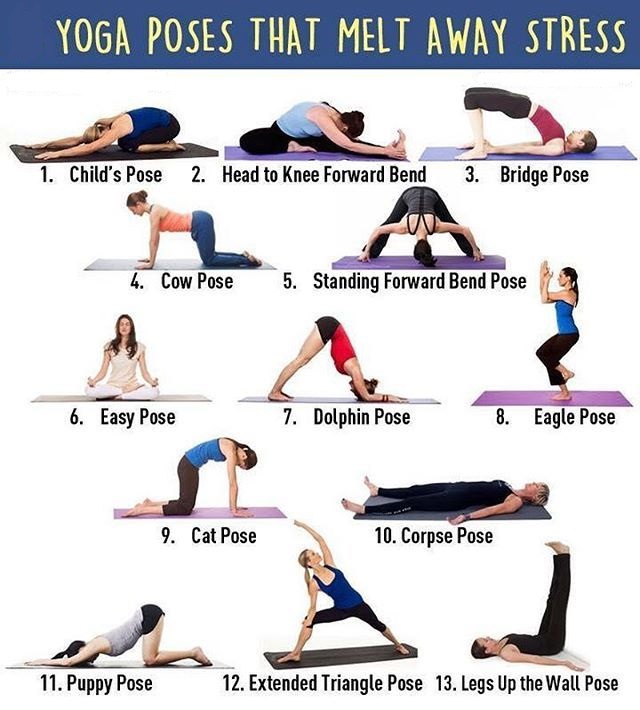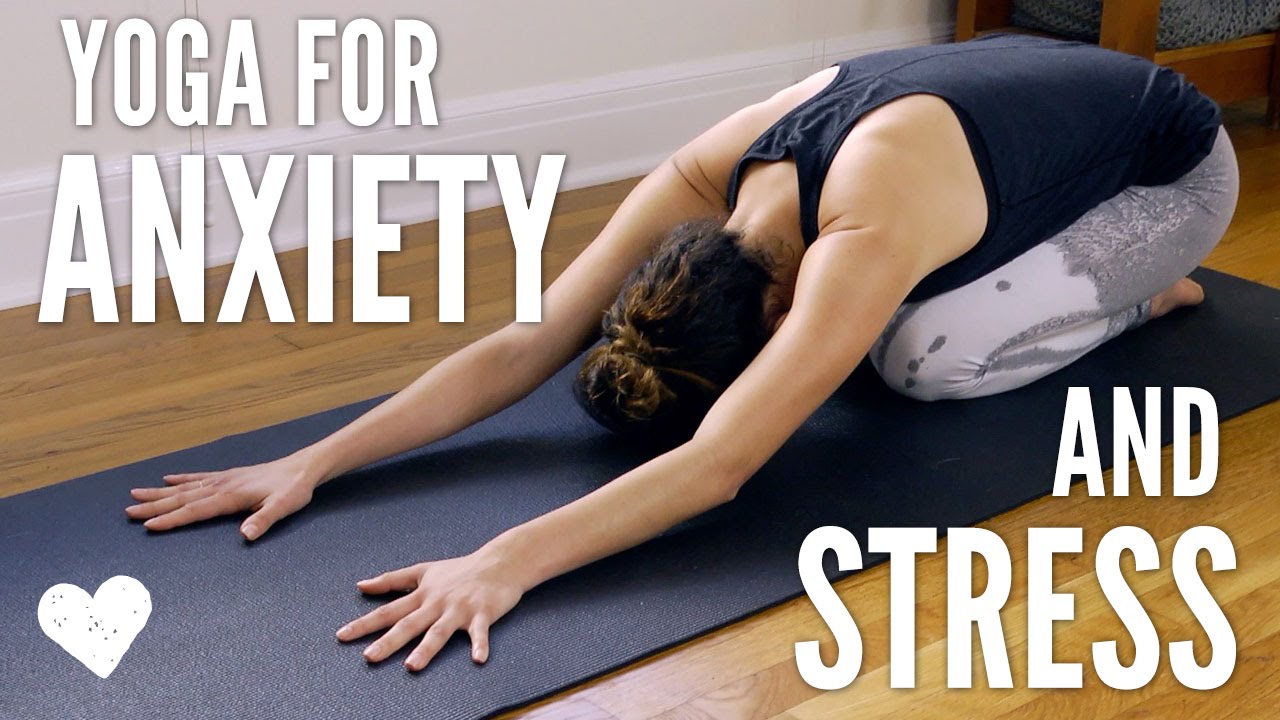Yoga can be an effective tool for stress relief, helping to calm the mind and relax the body. Incorporating yoga into your routine can alleviate tension and promote a sense of well-being, enabling you to better manage and reduce stress levels.
Practicing various yoga poses, breathing exercises, and meditation techniques can provide a holistic approach to stress relief, improving both physical and mental health. By engaging in regular yoga sessions, you can cultivate mindfulness, focus on the present moment, and reduce anxious thoughts.
Yoga also encourages deep relaxation, allowing you to release built-up tension and find inner peace. With its numerous benefits, yoga is a fantastic practice to incorporate into your daily life for stress relief.

Credit: www.calmsage.com
Yoga Poses For Stress Relief
Yoga is a powerful tool for managing stress and promoting relaxation. The physical movements, combined with deep breathing and mindfulness, can help calm the mind and release tension from the body. Incorporating specific yoga poses into your practice can further enhance these stress-relieving benefits. Here are a few essential poses that can help you find peace amidst the chaos:
Child’s Pose
One of the most relaxing and restorative yoga poses, Child’s Pose provides a sense of calm and inward focus. This pose gently stretches the hips, thighs, and lower back, which are common areas where stress tends to accumulate. To practice Child’s Pose:
- Kneel on the floor with toes together and knees apart, leaving a comfortable gap.
- Sit back on your heels and gently fold forward, draping your torso between your thighs.
- Extend your arms forward or rest them alongside your body, and allow your forehead to rest on the mat or a block.
- Take slow, deep breaths and let yourself melt into the pose, releasing any tension with each exhalation.
Cat-cow Pose
Combining two simple movements, Cat-Cow Pose gently massages the spine and releases tension in the neck and back. It also opens up the chest and improves breathing, promoting a sense of tranquility. Here’s how to do it:
- Start on your hands and knees, aligning your wrists beneath your shoulders and your knees beneath your hips.
- Inhale and arch your back, dropping your belly towards the mat while lifting your chest and chin. This is the Cow pose.
- As you exhale, round your spine and tuck your tailbone, bringing your chin to your chest. This is the Cat pose.
- Repeat these movements at a gentle and steady pace, synchronizing each breath with the corresponding movement. Let the rhythm of your breath calm your mind and soothe your body.
Forward Fold
A forward fold not only stretches the hamstrings and calves but also calms the mind and relieves stress. By letting your head hang, you encourage the body to relax and release any built-up tension. Follow these steps to practice the Forward Fold:
- Stand with your feet hip-width apart and your arms by your sides.
- Take a deep breath in as you lengthen your spine, lifting your chest and keeping your shoulders relaxed.
- Exhale and fold forward from the hips, keeping your spine long as you descend.
- Bend your knees if necessary and allow your hands to rest on the floor or on your legs, depending on your flexibility.
- Relax your neck and let your head hang heavily. Stay in this position for several breaths, feeling the calming effect throughout your body.
Legs-up-the-wall Pose
Legs-Up-The-Wall Pose, or Viparita Karani, is a surprisingly simple and restorative pose that can help reduce anxiety and stress levels. By elevating your legs, you promote healthy circulation and lymphatic drainage, while also quieting the mind. Here’s how you can do it:
- Find an open wall space and sit sideways against it.
- Slowly lie down on your back, extending your legs up the wall.
- Keep your arms relaxed by your sides, palms facing up.
- Close your eyes and take slow, deep breaths, allowing the gentle stretch and release to alleviate tension from your body.
- Stay in this pose for several minutes, gradually lengthening the time as your comfort allows.
By incorporating these calming yoga poses into your routine, you can find solace and relief from the daily stresses of life. Take a few moments each day to practice these poses, and allow yourself to let go of tension and embrace a sense of peacefulness.

Credit: www.hungry4fitness.co.uk
Breathing Techniques For Stress Relief
When life gets overwhelming and stress takes over, taking a moment to focus on your breath can be a powerful tool to find calm and promote relaxation. Breathing techniques are an integral part of yoga practice, and they can be easily incorporated into your daily routine to manage stress effectively. In this blog post, we will explore three simple yet effective breathing techniques – deep belly breathing, alternate nostril breathing, and box breathing – that can help you find serenity and reduce stress levels.
Deep Belly Breathing
Deep belly breathing, also called diaphragmatic breathing, is a technique that involves breathing deeply into your belly, rather than shallowly into your chest. It is a simple yet powerful tool to promote relaxation and reduce stress.
Here’s how you can practice deep belly breathing:
- Find a comfortable seated position. You can sit cross-legged on the floor or use a chair.
- Rest your hands gently on your belly, close your eyes, and take a moment to connect with your breath.
- Inhale deeply through your nose, allowing your belly to expand as you fill your lungs with air.
- Exhale slowly through your nose, feeling your belly gently deflate as you release the air.
- Continue this deep belly breathing pattern, focusing on the sensation of your breath as it flows in and out.
Breathe in slowly, counting to four, and exhale slowly, counting to four. Repeat this process for a few minutes or as long as you need to feel a sense of calm and relaxation.
Alternate Nostril Breathing
Alternate nostril breathing, also known as Nadi Shodhana, is a yogic breathing technique that aims to balance the flow of energy in the body and calm the mind.
Follow these steps to practice alternate nostril breathing:
- Sit in a comfortable position and relax your body.
- Close your right nostril with your right thumb and inhale deeply through your left nostril.
- Close your left nostril with your middle and ring fingers, and exhale through your right nostril.
- Inhale through your right nostril, then close it with your right thumb.
- Release your left nostril and exhale through it.
- Continue this pattern, alternating the nostrils after each inhale and exhale.
Practicing alternate nostril breathing for a few minutes can help restore balance and bring clarity to your mind, reducing stress and promoting relaxation.
Box Breathing
Box breathing, also referred to as square breathing, is a technique that helps regulate your breath and allows you to focus your attention, ultimately reducing stress and promoting a sense of calm.
Here’s how you can practice box breathing:
- Find a quiet and comfortable place to sit, ensuring your spine is straight.
- Inhale deeply through your nose, counting to four.
- Hold your breath for a count of four.
- Exhale slowly through your mouth, counting to four.
- Hold your breath for a count of four before inhaling again.
- Repeat this pattern for a few minutes, allowing yourself to focus on the rhythm and sensation of your breath.
Box breathing is an excellent technique to induce a state of calm and reduce stress, whether you practice it as a standalone exercise or incorporate it into your yoga or meditation practice.
Incorporating Yoga Into Daily Routine
When it comes to managing stress, incorporating yoga into your daily routine can be a game-changer. Not only does yoga help improve flexibility and strength, but it also has a calming effect on the mind and body. By setting aside time for yoga, creating a calming space, and building a consistent practice, you can reap the benefits of this ancient practice in no time.
Setting Aside Time For Yoga
Setting aside dedicated time for your yoga practice is essential for making it a regular part of your routine. By allocating a specific time each day, you prioritize your physical and mental well-being. Find a time that works best for you, whether it’s in the morning to kickstart your day or in the evening to wind down before bed. Consider the other commitments in your day and choose a time that you can consistently stick to.
Creating A Calming Space
Creating a calming space to practice yoga can greatly enhance your experience and help you relax more deeply. Designate a specific area in your home where you can roll out your yoga mat and be free from distractions. Keep the space clean, organized, and clutter-free. Consider adding elements like plants, soft lighting, or calming music to create a serene ambiance. Having a designated space will make it easier to mentally transition into your yoga practice and foster a sense of tranquility.
Building A Consistent Practice
Building a consistent yoga practice is key to reaping the full benefits of this ancient practice. Start by setting realistic goals and gradually increasing the duration and intensity of your sessions. Consistency is more important than intensity, so aim for shorter sessions that you can commit to on a regular basis. Make a schedule or use a yoga app to track your progress and stay motivated. Eventually, your yoga practice will become a habit and an integral part of your daily routine.

Credit: www.youtube.com
Frequently Asked Questions Of Yoga For Stress Relief
What Type Of Yoga Is Best For Stress Relief?
The best type of yoga for stress relief is Hatha Yoga. It combines gentle stretching, breathing exercises, and meditation to help relax the body and calm the mind. Regular practice can reduce stress levels and promote overall well-being.
Does Yoga Really Reduce Stress?
Yes, yoga genuinely reduces stress. It helps calm the mind and relaxes the body.
What Are The 5 A’s Of Stress Management?
The 5 A’s of stress management are: avoid stress triggers, alter your response to stress, adapt to stressful situations, accept what cannot be changed, and seek support when needed.
How Do You Release Stress From Your Body?
To release stress from your body, try deep breathing, exercising, and getting enough sleep. Engaging in activities like meditation, yoga, or taking a warm bath can also help. Additionally, make time for hobbies you enjoy, connect with loved ones, and prioritize self-care.
Conclusion
Practicing yoga can be a powerful tool for alleviating stress and promoting overall well-being. By incorporating gentle movements, deep breathing, and mindfulness techniques, yoga offers a holistic approach to stress relief. Whether you’re a beginner or an experienced practitioner, integrating a regular yoga practice into your routine can help to reduce anxiety, calm the mind, and improve physical and mental health.
So, embrace the benefits of yoga and embark on your journey to a stress-free life.
